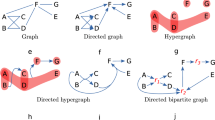Abstract
We clarify the relation between the algebraic conditions that must be satisfied by the reaction constants in general (mass–action) kinetics systems for the existence of detailed or complex balancing equilibria. These systems have a wide range of applications in chemistry and biology. Their main properties have been set by Horn, Jackson and Feinberg. We expect to extend our point of view to the study of qualitative features of the dynamical behavior of chemical interactions in molecular systems biology.
Similar content being viewed by others
References
Angeli, D., de Leenheer, P., & Sontag, E. D. (2007). A Petri net approach to the study of persistence in chemical reaction networks. Math. Biosci., 210, 598–618.
Burack, W. R., & Sturgill, T. (1997). The activating dual phosphorylation of MAPK by MEK is nonprocessive. Biochemistry, 36(20), 5929–5933.
Craciun, G., & Feinberg, M. (2006). Multiple equilibria in complex chemical reaction networks: II. The species-reactions graph. SIAM J. Appl. Math., 66(4), 1321–1338.
Craciun, G., Dickenstein, A., Shiu, A., & Sturmfels, B. (2009). Toric dynamical systems. J. Symb. Comput., 44, 1551–1565.
Craciun, G., Tang, Y., & Feinberg, M. (2006). Understanding bistability in complex enzymedriven reaction networks. Proc. Natl. Acad. Sci. USA, 103(23), 8697–8702.
Ederer, M., & Gilles, E. D. (2007). Thermodynamically feasible kinetic models of reaction networks. Biophys. J., 92(6), 1846–1857.
Eisenbud, D., & Sturmfels, B. (1996). Binomial ideals. Duke Math. J., 84(1), 1–45.
Feinberg, M. (1972/1973). Complex balancing in general kinetic systems. Arch. Ration. Mech. Anal., 49, 187–194.
Feinberg, M. (1979). Lectures on chemical reaction networks. Notes of lectures given at the Mathematics Research Center of the University of Wisconsin in 1979, available at: http://www.che.eng.ohio-state.edu/~FEINBERG/LecturesOnReactionNetworks.
Feinberg, M. (1989). Necessary and sufficient conditions for detailed balancing in mass action systems of arbitrary complexity. Chem. Eng. Sci., 44(9), 1819–1827.
Feinberg, M. (1995). The existence and uniqueness of steady states for a class of chemical reaction networks. Arch. Ration. Mech. Anal., 132(4), 311–370.
Ferrell, J. E. Jr., & Bhatt, R. (1997). Mechanistic studies of the dual phosphorylation of mitogenactivated protein kinase. J. Biol. Chem., 272(30), 19008–19016.
Gatermann, K., & Wolfrum, M. (2005). Bernstein’s second theorem and Viro’s method for sparse polynomial systems in chemistry. Adv. Appl. Math., 34(2), 252–294.
Gnacadja, G. (2009). Univalent positive polynomial maps and the equilibrium state of chemical networks of reversible binding reactions. Adv. Appl. Math., 43(4), 394–414.
Gunawardena, J. (2003). Chemical reaction network theory for in-silico biologists (Technical report). Available at: http://vcp.med.harvard.edu/papers/crnt.pdf.
Gunawardena, J. (2007). Distributivity and processivity in multisite phosphorylation can be distinguished through steady-state invariants. Biophys. J., 93, 3828–3834.
Gunawardena, J. (2009). Models in systems biology: the parameter problem and the meanings of robustness. In H. Lodhi & S. Muggleton (Eds.), Elements of computational systems biology. New York: Wiley.
Horn, F. (1972/1973). Necessary and sufficient conditions for complex balancing in chemical kinetics. Arch. Ration. Mech. Anal., 49, 172–186.
Horn, F. (1973). Stability and complex balancing in mass–action systems with three short complexes. Proc. R. Soc. Lond. Ser. A, 334, 331–342.
Horn, F. (1974). The dynamics of open reaction systems. In Mathematical aspects of chemical and biochemical problems and quantum chemistry (Proc. SIAM–AMS sympos. appl. math., New York, 1974) (pp. 125–137). SIAM–AMS proc.: Vol. VIII. Providence: Am. Math. Soc.
Horn, F., & Jackson, R. (1972). General mass action kinetics. Arch. Ration. Mech. Anal., 47, 81–116.
King, E. L., & Altman, C. (1956). A schematic method of deriving the rate laws for enzyme-catalyzed reactions. J. Phys. Chem., 60(10), 1375–1378.
Manrai, A., & Gunawardena, J. (2008). The geometry of multisite phosphorylation. Biophys. J., 95, 5533–5543.
Markevich, N. I., Hoek, J. B., & Kholodenko, B. N. (2004). Signaling switches and bistability arising from multisite phosphorylation in protein kinase cascades. J. Cell Biol., 164(3), 353–359.
Schuster, S., & Schuster, R. (1989). A generalization of Wegscheider’s condition. Implications for properties of steady states and for quasi-steady-state approximation. J. Math. Chem., 3, 25–42.
Shinar, G., Alon, U., & Feinberg, M. (2009). Sensitivity and robustness in chemical reaction networks. SIAM J. Appl. Math., 69(4), 977–998.
Sontag, E. (2001). Structure and stability of certain chemical networks and applications to the kinetic proofreading model of T-cell receptor signal transduction. IEEE Trans. Autom. Control, 46, 1028–1047.
Stanley, R. P. (1999). Cambridge studies in advanced mathematics: Vol. 62. Enumerative combinatorics: Vol. 2. Cambridge: Cambridge University Press. With a foreword by Gian-Carlo Rota and Appendix 1 by Sergey Fomin.
Vlad, M. O., & Ross, J. (2009). Thermodynamically based constraints for rate coefficients of large biochemical networks. WIREs Syst. Biol. Med., 1(3), 348–358.
Author information
Authors and Affiliations
Corresponding author
Additional information
Both authors were partially supported by UBACYT X064, CONICET PIP 112-200801-00483 and ANPCyT PICT-2008-0902, Argentina.
Rights and permissions
About this article
Cite this article
Dickenstein, A., Pérez Millán, M. How Far is Complex Balancing from Detailed Balancing?. Bull Math Biol 73, 811–828 (2011). https://doi.org/10.1007/s11538-010-9611-7
Received:
Accepted:
Published:
Issue Date:
DOI: https://doi.org/10.1007/s11538-010-9611-7




